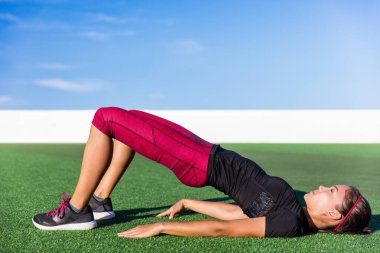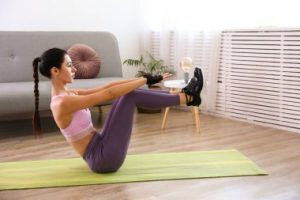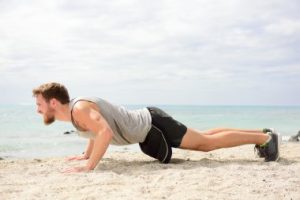
Can You Do Bodyweight Exercises Daily (7 Helpful Guidelines)
Can you do bodyweight exercises daily? Many fitness enthusiasts wonder about the benefits and practicality of incorporating daily bodyweight routines into their lives. Whether aiming for strength gains or simply enhancing overall fitness, consistent practice under proper guidance can yield significant results. Can you imagine sculpting a stronger, fitter you without ever stepping foot in a gym or picking up a single dumbbell?
The secret lies in the untapped potential of bodyweight exercises, a versatile and accessible form of fitness that doesn’t just offer convenience but also promises transformative results. Every push-up, squat, and plank taps into your body’s innate strength, making it possible to challenge your muscles and boost your endurance using nothing but your own weight. But the burning question is, can you harness this power daily without hitting a plateau or risking injury? Let’s dive into the world of daily bodyweight workouts to uncover the surprising benefits and hidden pitfalls of this minimalist approach to fitness.

Can You Do Bodyweight Exercises Daily
Yes, you can do bodyweight exercises daily. These exercises are a great way to build strength, improve flexibility, and enhance overall fitness. They are versatile and can be adapted to different fitness levels. However, it’s important to listen to your body and ensure you’re not overtraining. Rest and recovery are key components of any fitness routine.
Benefits of Daily Bodyweight Exercises
Bodyweight exercises offer numerous benefits when performed daily. They help in building muscle strength, increasing endurance, and improving cardiovascular health. Exercises like push-ups, squats, lunges, and planks engage multiple muscle groups, promoting functional fitness. This type of workout can enhance balance, coordination, and mobility, making everyday activities easier and safer.
Additionally, because they require no equipment, bodyweight exercises can be performed anywhere, making them highly convenient and accessible. Over time, consistent practice can lead to significant improvements in physical appearance, including increased muscle tone and reduced body fat. Furthermore, daily exercise boosts mental health by reducing stress, improving mood, and enhancing cognitive function.
Potential Risks and Precautions
While daily bodyweight exercises can be highly beneficial, it is crucial to be mindful of potential risks. Overtraining can lead to muscle fatigue, joint pain, and even injuries. It is essential to vary your workout routine to target different muscle groups on different days, allowing some muscles to rest while others are being worked.
Proper form and technique are paramount to prevent injuries; therefore, it might be beneficial to seek guidance from a fitness professional, especially if you are new to exercise. Listening to your body and recognizing signs of overexertion, such as persistent soreness, decreased performance, or unusual fatigue, is vital. Incorporating adequate rest, hydration, and nutrition into your routine will support recovery and overall health.
Optimizing Your Bodyweight Exercise Routine
To maximize the benefits of daily bodyweight exercises, it is important to structure your routine effectively. Begin with a warm-up to prepare your muscles and joints for the workout, reducing the risk of injury. Include a variety of exercises that target different muscle groups, such as upper body, lower body, and core. This could involve a mix of push-ups, squats, lunges, and planks. Gradually increase the intensity and duration of your workouts to continue making progress. Additionally, integrating flexibility and mobility exercises, such as yoga or stretching, can enhance overall performance and reduce the risk of injury. Keeping a workout log can help track your progress and adjust your routine as needed to ensure continuous improvement.
Benefits of Bodyweight Exercises
Bodyweight exercises offer a multitude of benefits, particularly in terms of versatility and accessibility. One of the foremost advantages is that they can be performed virtually anywhere, requiring no special equipment or gym membership. This makes them an ideal choice for individuals with busy schedules, those who travel frequently, or anyone without access to a fitness facility.
The versatility of bodyweight exercises allows for a comprehensive workout that can target all major muscle groups, from legs and core to upper body strength. They can be easily modified to suit any fitness level, from beginner to advanced, by adjusting the intensity, duration, and complexity of the movements. For example, a basic push-up can be altered to increase difficulty by performing it on one hand or elevating the feet.
Additionally, bodyweight exercises promote functional fitness, improving strength, balance, flexibility, and endurance in ways that translate to everyday activities and sports performance. They also reduce the risk of injury compared to weightlifting, as they use natural body movements and do not place excessive stress on the joints. The accessibility and versatility of bodyweight exercises make them an inclusive and effective way to maintain physical fitness, catering to a wide range of goals, whether it’s building muscle, losing weight, enhancing cardiovascular health, or improving overall well-being.
Factors to Consider Before Starting Daily Bodyweight Exercises
Before starting daily bodyweight exercises, it is crucial to consider several factors to ensure a safe, effective, and sustainable fitness regimen. Firstly, assessing your current fitness level and prior exercise experience is fundamental. Beginners or those returning to exercise after a long hiatus should start with basic movements, focusing on form and gradually increasing intensity to prevent injury. For those with more experience, incorporating advanced variations and maintaining a balanced routine that targets all major muscle groups is essential.
Setting realistic goals and expectations is another vital aspect. Understanding that progress may be gradual and setting achievable milestones can help maintain motivation and prevent discouragement. Additionally, it’s important to consider any pre-existing health conditions or physical limitations, which might necessitate modifications to certain exercises or seeking guidance from a healthcare professional or certified trainer.
Moreover, scheduling regular rest days and listening to your body to avoid overtraining is key. Ensuring proper nutrition and hydration will support recovery and performance. Finally, creating a supportive environment, whether through finding a workout buddy, joining a fitness community, or setting up a dedicated workout space at home, can enhance consistency and enjoyment. By carefully considering these factors, individuals can embark on a daily bodyweight exercise routine that promotes long-term health and fitness.
Feasibility of Daily Bodyweight Exercise Routine
Impact on muscle recovery and growth
Engaging in a daily bodyweight exercise routine can be highly beneficial for overall fitness, but it’s essential to consider its feasibility concerning muscle recovery and growth. Incorporating rest and recovery days is paramount to avoid overtraining, which can lead to muscle fatigue, injury, and diminished performance. Muscles need time to repair and strengthen after the micro-tears that occur during exercise; without adequate recovery, progress can stall, and the risk of overuse injuries increases.
Moreover, the role of nutrition and hydration cannot be overstated. Proper nutrition provides the necessary building blocks, such as proteins and amino acids, which are crucial for muscle repair and growth. Carbohydrates replenish glycogen stores, fueling future workouts, while healthy fats support overall cellular function. Hydration is equally critical, as it aids in nutrient transport, joint lubrication, and temperature regulation. Dehydration can impede performance and recovery, emphasizing the need for consistent fluid intake.
To optimize a daily bodyweight exercise routine, one must strategically plan rest days, perhaps alternating between different muscle groups to allow for recovery, and ensure a balanced diet rich in essential nutrients and sufficient hydration. This holistic approach ensures that the body can adequately recover and grow stronger, enhancing the effectiveness and sustainability of the exercise regimen.

Variation in intensity and exercises
The feasibility of a daily bodyweight exercise routine is high, provided it incorporates variation in intensity and exercises, balanced design, and attention to proper form. A well-rounded routine should target all major muscle groups to ensure comprehensive strength and endurance development. This can be achieved by incorporating a mix of exercises such as push-ups, squats, lunges, planks, and burpees, which engage different muscle groups and prevent overuse injuries. Additionally, varying the intensity—from low to high—by adjusting the number of repetitions, sets, and rest intervals can help manage fatigue and promote muscle recovery.
For example, alternating between high-intensity interval training (HIIT) days and low-intensity recovery days can enhance cardiovascular health and muscular endurance without causing excessive strain. Designing a balanced routine also means including flexibility and mobility exercises like yoga or dynamic stretches, which are crucial for maintaining joint health and preventing stiffness.
Proper form is paramount to prevent injury; this involves maintaining correct posture, using controlled movements, and avoiding overextension. Resources such as instructional videos or guidance from fitness professionals can be invaluable in learning and maintaining proper form. By prioritizing balance, variety, and technique, a daily bodyweight exercise routine can be both safe and effective, promoting long-term physical health and fitness.
Potential Daily Bodyweight Exercise Routine
Warm-up exercises
Warming up before engaging in a bodyweight exercise routine is crucial for preparing the body for physical activity, preventing injuries, and enhancing overall performance. A well-structured warm-up gradually increases the heart rate, boosts blood flow to the muscles, enhances flexibility, and primes the nervous system for the upcoming workout. It also helps to mentally prepare individuals, transitioning them from a state of rest to one of activity.
Dynamic warm-up routines, which involve movement-based stretches and activities, are particularly effective. Examples of dynamic warm-up exercises include leg swings, where individuals swing their legs forward and backward to activate the hip flexors and hamstrings, and arm circles, which loosen the shoulder joints and improve upper body mobility. High knees and butt kicks are also beneficial, raising the heart rate and engaging the core and lower body muscles.
Additionally, lunges with a twist can effectively stretch the hip flexors and engage the core, while inchworms target the hamstrings, shoulders, and core. These dynamic movements not only prepare the muscles and joints but also mimic the actions of the subsequent bodyweight exercises, ensuring a seamless transition into the main workout. By incorporating a thorough dynamic warm-up, individuals can enhance their performance, reduce the risk of injury, and ensure a more efficient and effective exercise session.
Main workout session
A potential daily bodyweight exercise routine can be both simple and effective, focusing on fundamental exercises that engage major muscle groups without requiring specialized equipment. Begin with a main workout session that includes a variety of exercises such as push-ups, squats, lunges, planks, and more. Push-ups are excellent for upper body strength and can be varied by hand placement to target different muscle groups. Squats and lunges help build lower body strength and improve balance and stability. Planks are superb for core strength and stability.
Structuring your sets and repetitions can vary based on your fitness level and goals. For beginners, starting with 2-3 sets of 10-15 repetitions per exercise can provide a solid foundation. Intermediate and advanced individuals may increase intensity by adding more sets, increasing repetitions, or incorporating variations such as plyometric movements or isometric holds.
Remember to focus on proper form throughout each exercise to maximize effectiveness and minimize injury risk. This routine not only enhances muscular strength and endurance but also promotes overall cardiovascular health and flexibility when performed consistently. Adjustments can be made over time as fitness levels improve, ensuring continuous challenge and progress.
Cool-down and stretching
Benefits of cooling down
A well-rounded daily bodyweight exercise routine is not complete without a thoughtful cool-down and stretching session to ensure optimal recovery and flexibility. Cooling down after a workout offers numerous benefits that enhance overall fitness and reduce the risk of injury. Firstly, it helps regulate blood flow by gradually lowering heart rate and easing the body from a heightened state of exertion to a relaxed state. This gradual transition can also prevent dizziness or fainting by stabilizing blood pressure.
Moreover, cooling down promotes the efficient removal of metabolic waste products like lactic acid, which can accumulate during intense exercise and contribute to muscle soreness if not properly flushed out. Additionally, it aids in preventing the pooling of blood in the extremities, reducing the likelihood of post-exercise cramping. A typical cool-down may involve light aerobic activity such as walking or gentle jogging, followed by static stretching to target major muscle groups.
Examples of post-workout stretches
Post-workout stretches are crucial for maintaining and improving flexibility, which is essential for joint health and overall mobility. By stretching after exercise, muscles that have been contracted and shortened during the workout are lengthened back to their resting state. This helps to improve muscle elasticity and range of motion, which can enhance athletic performance and reduce the risk of injuries related to muscle tightness or imbalance.
Common post-workout stretches include the hamstring stretch, where one leg is extended straight while leaning forward at the hips, and the quadriceps stretch, where one foot is lifted towards the buttocks while standing. Other effective stretches include the calf stretch, where one leg is placed behind the other and the heel is pressed into the ground, and the chest stretch, where the arms are clasped behind the back and pulled gently upwards. Each stretch should be held for 15-30 seconds, allowing the muscles to relax and lengthen gradually. Incorporating these stretches into a daily bodyweight exercise routine not only enhances flexibility and reduces muscle tension but also promotes relaxation and mental clarity, contributing to an overall sense of well-being.
Tips for Maintaining Consistency and Progress
Maintaining consistency and progress in a daily bodyweight exercise routine requires dedication and strategic planning. First and foremost, establish a realistic schedule that fits into your daily life without overwhelming you. Consistency is key, so aim to exercise at the same time each day to build a habit. Start with manageable goals and gradually increase intensity or duration as your strength and endurance improve.
Variety is crucial to prevent boredom and ensure all muscle groups are engaged, so incorporate different exercises such as push-ups, squats, lunges, and planks. Listen to your body and rest when needed to avoid burnout or injury. Keep track of your progress, whether through a journal or fitness app, to stay motivated and celebrate achievements. Surround yourself with support, whether it’s a workout buddy, online community, or fitness coach, to stay accountable and inspired. Lastly, prioritize proper nutrition and hydration to fuel your workouts and aid in recovery. By adhering to these tips and maintaining a positive mindset, you’ll establish a sustainable routine that promotes both consistency and progress in your daily bodyweight exercise regimen.

Potential Challenges and How to Overcome Them
Incorporating a daily bodyweight routine brings numerous benefits but also presents potential challenges that require strategic approaches to overcome. Firstly, muscle soreness and fatigue can deter consistency. To counter this, it’s crucial to incorporate adequate warm-ups and cooldowns, along with gradual progression in intensity to allow muscles to adapt without strain. Additionally, maintaining hydration and nutrition levels are pivotal in aiding muscle recovery.
Secondly, addressing boredom and monotony is essential to sustain motivation. Introducing variety through different exercise variations, incorporating interval training, or even joining virtual workout communities can inject excitement and keep workouts engaging.
Lastly, modifying exercises for injury prevention is paramount. Understanding proper form and technique, listening to your body’s cues, and seeking guidance from fitness professionals can prevent overuse injuries. Incorporating stretches and mobility exercises into routines also enhances flexibility and reduces injury risks. By proactively addressing these challenges, individuals can ensure their daily bodyweight routines remain effective, enjoyable, and sustainable in the long term.
Frequently Asked Questions (FAQ) about Can You Do Bodyweight Exercises Daily
Q1. Can you do bodyweight exercises every day?
. Yes, you can do bodyweight exercises daily. These exercises typically involve using your own body weight as resistance, making them less likely to cause overtraining or injury compared to heavy weightlifting. However, it’s essential to listen to your body and ensure you get adequate rest when needed.
Q2. What are the benefits of daily bodyweight exercises?
A. Daily bodyweight exercises can improve cardiovascular health, increase strength and flexibility, boost metabolism, enhance mental health, and help maintain a healthy weight. They also improve coordination and balance.
Q3. What types of bodyweight exercises can I do every day?
A. You can incorporate a variety of exercises, such as push-ups, squats, lunges, planks, burpees, and mountain climbers. Mixing different exercises ensures that various muscle groups are worked on and helps prevent boredom.
Q4. Do I need to warm up before doing daily bodyweight exercises?
A. Yes, warming up is crucial to prepare your muscles and joints for the workout, reducing the risk of injury. A simple warm-up can include light cardio like jogging in place or dynamic stretches.
Q5. Is it necessary to have rest days from bodyweight exercises?
A. While bodyweight exercises are generally safe to perform daily, incorporating rest days or active recovery days can help prevent overuse injuries and allow muscles to repair and grow. You can alternate between different muscle groups to give some areas a break.
Q6. How long should a daily bodyweight workout session be?
A. The duration can vary based on your fitness level and goals. A daily session can range from 20 minutes to an hour. Even short sessions of 10-15 minutes can be beneficial if done consistently.
Q7. Can beginners do bodyweight exercises daily?
A. Yes, beginners can start with daily bodyweight exercises but should begin with shorter, less intense sessions. Gradually increase the intensity and duration as your fitness level improves.
Q8. How do I avoid overtraining with daily bodyweight exercises?
A. To avoid overtraining, vary the intensity and focus of your workouts, listen to your body, ensure proper form, and get enough sleep and nutrition. Including stretching and flexibility exercises can also aid in recovery.
Q9. Can daily bodyweight exercises help with weight loss?
A. Yes, consistent bodyweight exercises can aid in weight loss by burning calories, increasing muscle mass, and boosting your metabolism. Pairing exercise with a healthy diet is crucial for optimal results.
Q10. What should I do if I feel sore from daily bodyweight exercises?
A. If you experience soreness, consider incorporating rest or active recovery days with light activities such as walking or yoga. Ensure you’re doing proper warm-ups and cool-downs, and stay hydrated. Stretching and foam rolling can also help alleviate soreness.
Q11. Can I build muscle with daily bodyweight exercises?
A. Yes, you can build muscle with bodyweight exercises by progressively increasing the difficulty of your workouts. This can be done by adding more repetitions, decreasing rest time, or incorporating advanced variations of exercises.
Q12. Is it safe to do bodyweight exercises daily if I have a pre-existing condition?
A. If you have a pre-existing medical condition, consult with a healthcare provider before starting any new exercise routine. They can provide personalized advice and ensure that the exercises are safe for your specific condition.
Conclusion
In conclusion, engaging in bodyweight exercises daily can offer numerous benefits, including improved muscle strength, endurance, flexibility, and cardiovascular health. The convenience and accessibility of bodyweight workouts make them an excellent choice for individuals seeking to maintain a consistent fitness routine without the need for specialized equipment or gym access. However, it is essential to listen to your body and incorporate variety, rest, and proper technique to prevent overuse injuries and ensure balanced muscle development. By tailoring the intensity and volume of these exercises to your fitness level and goals, daily bodyweight workouts can be a sustainable and effective component of a healthy lifestyle.